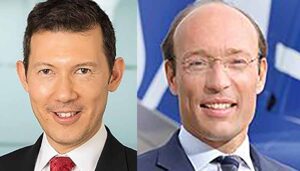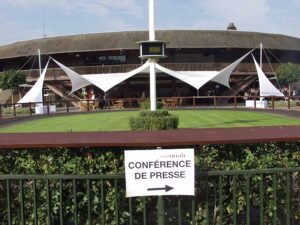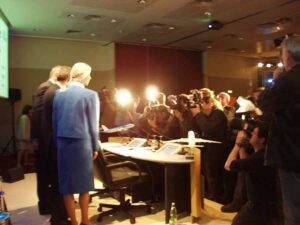Michael O’Leary;s views on airline consolidation
By Eoghan Corry
It was the multi-national airline before multi-national existed. The Scandinavians didn’t wait for Europe to unite their interests.
As early as 1946, they merged their national airlines under one flag, SAS, which was owned by the three states. Its original emblem featured three flags on its outstretched wings: the Danish white cross, the Norwegian blue, and the Swedish yellow.
This symbolic sharing of sovereignty was shattered by successive crises and the Covid-19 pandemic. In 2018, Norway sold its shares, and in 2022, Sweden refused to participate in yet another rescue plan, leading the company to seek protection under US bankruptcy law.

Only Denmark persists. It is participating in the new funding round, which will have an American investment fund, Castlelake, as its largest shareholder, and will bring the Air France-KLM group in through the front door. Out of a total investment of just over €1bn, the majority will be provided by Castlelake, which will hold 32pc of the capital, followed by the Danish state at 26pc, and the Franco-Dutch company at 20pc.
This is a strategic move for Air France-KLM, which, by investing only €145m, gains a significant ally. SAS, a founding member of Star Alliance, Lufthansa’s network, will join the rival SkyTeam alliance. But, more importantly, Air France-KLM’s parent company has an option to become the controlling shareholder of the Scandinavian airline in two years.
This is a remarkable turnaround for a company that lost €11bn in the pandemic, was saved by the French state, and now, after nearly two profitable years, is in a position to participate in the consolidation of the European skies.
Air France now holds 20pc of SAS
The winning bidder consortium is completed by Castlelake (US) and Lind Invest (Denmark) along with the Danish state. Castlelake is a global alternative investment manager specializing in aviation, specialty finance, and real assets. With its focus ranging from value-oriented to income and investment grade credit, Castlelake currently manages assets worth approximately US$22bn. https://www.castlelake.com
Lind Invest is a single family office that was established by Henrik Lind in 2002. As an independent long-term investor and business owner, Lind Invest has accumulated equity totalling US$1.2bn. Their investment strategy involves being opportunistic and actively executing as an owner, with a focus on adding value in company transformations and navigating complex corporate situations.
The equity distribution among the investors is as follows: Castlelake will hold 32.0pc, Denmark 25.8pc, AF-KLM 19.9pc, Lind Invest 8.6pc, and 13.6pc will be allocated to creditors. The agreed transaction structure involves a total investment of approximately US$1.17bn for the reorganized SAS.
Existing shareholders in SAS AB were wiped out and only a modest recovery is expected for the holders of commercial hybrid bonds. Shares in SAS tumbled 95pc after the deal was announced. The group will delist from bourses.
As part of the deal, SAS will depart from Star Alliance and join SkyTeam and in due course.
The winning bid, which was approved by the US Court as part of the equity raise process, has the backing of the Official Committee of Unsecured Creditors.
Around US$325m will be allocated to general unsecured creditors in the form of cash and equity. Recovery for these creditors will likely be between 5-20pc of the nominal value of their claims, depending on various factors such as the entities against which the claims are made, any guarantee claims involved, and the entities responsible for those guarantees.
20 years later: Spinetta’s web

It is 20 years, almost exactly, since the latest phase of the consolidation process roared into action at a press conference in Paris. I was there, asking impertinent questions of Jean Cyril Spinetta that he answered with a smile. I asked if they cost savings that were being discussed would be passed on to customers. I am not sure that it had occurred to anybody at the top table, where Mr Spinetta sat with erstwhile CEO of KLM Leo Van Wijk, that this was a good idea. That is certainly the impression I took home with me.

Much of the discussion at the merger of Air France and KLM was whether the larger entity would smother its northern cousin. KLM gave lots of reassurance as to the Dutch journalists about identity and customer service. Oddly, 20 years later, it is not clear whether the reassurances stand. Particularly at times of strife and air traffic control strikes, the alternative of routing passengers through Amsterdam rather than through. Paris has been a huge advantage for travel agents. The Air France KLM combination did not, as IAG and Lufthansa have done, embark on a round of further acquisitions. It was as if they were comfortable in their alliance.

Since then, consolidation has reshaped the landscape of the European airline industry. Noteworthy examples include the merger of Air France and KLM in 2004, the merger of British Airways and Iberia to form International Airlines Group (IAG) in 2011, their subsequent acquisition of Aer Lingus in 2015, the acquisition of Air Berlin by Lufthansa in 2017 and most recently the Lufthansa Group’s acquisition of Italy’s ITA.
Consolidation has been driven by three factors, economies of scale, operating costs, and competitive positions. Alliances and partnerships between different airlines have also played a role in expanding networks and enhancing connectivity.
The list of independent carriers continues to shrink.
Long haul dominated by three carriers

Long haul has become a trefoil worthy of the old Aer Lingus logo. Consolidation has already given three quarters of the wide-body capacity operated to or from Europe to just three operators.
According to the July 2023 ASKs, the wide-body capacity is split relatively evenly between carriers based within and outside the region. However, consolidation among the carriers based within the region is well underway, with two-thirds of the wide-body capacity already held by the three major network groups. If the deals for SAS, ITA, and Air Europa go through, the big three would control approximately 73pc of the capacity.
The big three’s influence is enhanced by venture agreements with airlines based outside the region. When factoring in these joint venture partners, the big three could potentially reach close to 60pc of the market share if the mentioned deals materialize.
That leaves Air Caraïbes, Condor, Corsair, Finnair, French Bee, LOT, Norwegian Air Shuttle, Tap, Tui and Virgin. Virgin stands out as the largest operator not yet owned by the big three network groups. With Delta holding a 49pc stake in Virgin and the majority of its flights being part of the transatlantic joint venture with Air France-KLM, it’s unlikely we would see a change in ownership to either of the other two groups. Even if AF-KLM were to acquire Virgin, it wouldn’t significantly change the strategic perspective since they already cooperate closely.
TUI, as a diversified leisure and tourism business, is another significant player almost as large as the “big three” network groups. Given its integration with its other leisure businesses, it’s unlikely that TUI would consider selling its airlines, and the big three may not have much interest even if it did.
TAP Air Portugal holds strategic importance, particularly in the Europe-Brazil market, and it is the largest remaining long-haul operator that could potentially be “in play.” Last week, the Portuguese government announced its intention to sell at least 51pc of the airline, which garnered interest from all three network groups. As TAP is currently part of the Star Alliance, a potential deal would influence the competitive position between the big three groups, considering it’s not currently part of Lufthansa’s joint venture arrangements.
Finnair, with its Helsinki hub, plays a significant role in serving the Europe to China and North Asian markets. While most of its wide-body capacity is operated under joint ventures with IAG and its partners, a deal with IAG seems like the logical “end state.” However, Finnair faces challenges due to the closure of Russian airspace to European carriers, which may delay any potential agreement until the issue is resolved.
The remaining independent operators, such as French bee, Air Caraïbes, Corsair, Norse, and Condor, primarily focus on point-to-point and leisure travel. While the big three network groups do have interests in the low-cost and leisure markets, these airlines may be of less strategic significance to them. However, if Norse manages to demonstrate real success in the development of long-haul, low-cost operations, that could potentially change the dynamics.
Lastly, LOT Polish Airlines, a member of the Star Alliance and utilizing Lufthansa’s frequent flyer program, Miles and More, might seem like a natural fit for acquisition by the Lufthansa Group. However, given the historical political dynamics between Poland and Germany, it’s uncertain if such a deal would be feasible.
Ryanair kings of short haul without consolidating
Short-haul airlines by their nature have smaller and less expensive aircraft, making it less demanding to meet their scale requirements. Ryanair and easyJet remain prominent players in the short-haul market with their low-cost business models, almost immune to the consolidation landscape around them.
It also explains why there are still many small airlines in the short-haul sector compared to long-haul. Ryanair stands out as the largest player in the chart, putting pressure on other low-cost carriers to consolidate and create a similarly sized rival. An obvious possibility would be for the second and third largest low-cost airlines, EasyJet and Wizz, to merge, although previous discussions between them fell through. Another option for EasyJet could be considering a partnership with Jet2, an English based airline that has experienced significant growth in recent years.
Norwegian, on the other hand, is in a less certain position, especially after acquiring regional operator Widerøe. The remaining carriers on the chart, including Agean, Volotea, Smartwings, Icelandair, and Air Baltic, may not have a significant impact on the larger players in the industry. While there has been speculation about a potential acquisition of EasyJet by IAG, it would face challenges due to competition regulations.
It seems unlikely for network groups to acquire sizable low-cost players due to valuation mismatches. The difference in valuation multiples between the two types of airlines makes it difficult to justify a premium acquisition when the network groups’ shares trade at significantly lower multiples. Unless there is a rerating of the network groups’ shares, it’s difficult to see how such deals could be feasible.
Over to the regulators
While progress has been made through joint ventures and partnerships, it seems that the relaxation of airline ownership and control restrictions on a global scale is not as likely as it appeared three decades ago.
You mentioned that there are still a few regional consolidation deals in progress that will keep everyone busy and generate fees for bankers. It appears that the network carriers have their hands full with ongoing deals, and the TAP privatisation in 2024 might mark the end game for European consolidation among the big three network airline groups.
In the short-haul low-cost segment, there may still be opportunities for significant moves. Ryanair, being a dominant player, seems to be in a favourable position. While a deal between other low-cost airlines could create a stronger competitor, it also carries the risk of management distraction and integration costs.
Ryanair, with its size advantage, has long maintained it does not have a strategic need to acquire other airlines (remember Buzz?) and can focus on organic growth.
Ryanair does possess considerable financial firepower, as powerful as any of the European airline groups. Michael O’Leary is fond of saying there will be three big, consolidated groups and Ryanair there to keep them honest. His rejected bid for Aer Lingus indicates that, if the circumstances are right, he might be in the consolidation business himself.



